A) bring about a more efficient allocation of resources.
B) bring about a less efficient allocation of resources.
C) not bring about a reallocation of resources unless there is government regulation.
D) not bring about a reallocation of resources unless firms are subsidized.
Correct Answer

verified
Correct Answer
verified
Multiple Choice
Refer to the figure below. 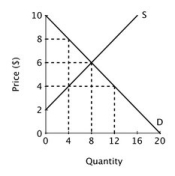 If this market is unregulated, the economic surplus received by consumers is:
If this market is unregulated, the economic surplus received by consumers is:
A) $4.
B) $8.
C) $16.
D) $24.
Correct Answer

verified
Correct Answer
verified
Multiple Choice
Which of the following is an example of the rationing function of price?
A) Switching from a Ph.D. in economics to one in finance because finance salaries are higher
B) Bill Gates purchasing the Mona Lisa for $5 billion
C) A firm attempting to lower its explicit costs
D) Government price controls
Correct Answer

verified
Correct Answer
verified
Multiple Choice
If the demand curve fails to capture all of the benefits of consumption, then the:
A) equilibrium price will be efficient but the equilibrium quantity will be inefficiently large.
B) equilibrium price will be inefficiently low.
C) government needs to impose regulations that require more consumption.
D) equilibrium price will be inefficiently high.
Correct Answer

verified
Correct Answer
verified
Multiple Choice
The No-Cash-on-the-Table Principle states that there are:
A) never unexploited opportunities available to individuals.
B) never unexploited opportunities available to individuals in equilibrium.
C) sometimes unexploited opportunities available to individuals in equilibrium.
D) always unexploited opportunities available to individuals.
Correct Answer

verified
Correct Answer
verified
Multiple Choice
The allocative function of price is to:
A) distribute scarce goods and services to those consumers who value them the most highly.
B) ensure that firms in perfectly competitive markets earn an economic profit.
C) direct resources away from markets that are overcrowded and toward markets that are underserved.
D) provide subsidies to low-income families so they can purchase essential goods and services.
Correct Answer

verified
Correct Answer
verified
Multiple Choice
One assumption of the perfectly competitive model is free entry and exit. This assumption most directly leads to the implication that:
A) firms will have to spend money on advertising.
B) positive economic profit is only possible in the short run.
C) firms will compete on the basis of better service rather than lower prices.
D) a long-run equilibrium cannot be achieved.
Correct Answer

verified
Correct Answer
verified
Multiple Choice
If all firms in a perfectly competitive industry are experiencing economic losses, then:
A) some firms will exit the industry, until economic profit is positive.
B) some firms will exit the industry, until accounting profit equals zero.
C) all existing firms will stay in the industry, hoping for better times.
D) some firms will exit the industry, until economic profit equals zero.
Correct Answer

verified
Correct Answer
verified
Multiple Choice
In a market with barriers to entry:
A) firms will earn zero economic profit in the long run.
B) economic profit will not fall to zero in the long run.
C) prices will direct productive resources toward underserved markets.
D) the implications of Adam Smith's theory of the invisible hand can be expected to hold.
Correct Answer

verified
Correct Answer
verified
Multiple Choice
Refer to the figure below. 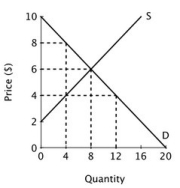 If a price ceiling were imposed at $4, producer surplus would be:
If a price ceiling were imposed at $4, producer surplus would be:
A) $24.
B) $16.
C) $8.
D) $4.
Correct Answer

verified
Correct Answer
verified
Multiple Choice
Which of the following is NOT necessarily true in a market equilibrium?
A) Price represents the value of an extra unit of consumption.
B) Both rich and poor have adequate access to the good.
C) Price represents the cost of an extra unit of production.
D) All mutually beneficial trades have been made.
Correct Answer

verified
Correct Answer
verified
Multiple Choice
Last year Christine worked as a consultant. She hired an administrative assistant for $15,000 per year and rented office space (utilities included) for $3,000 per month. Her total revenue for the year was $100,000. If Christine hadn't worked as a consultant, she would have worked at a real estate firm earning $40,000 a year. Christine's opportunity cost of working as a consultant last year was ________.
A) $15,000
B) $51,000
C) $40,000
D) $36,000
Correct Answer

verified
Correct Answer
verified
Multiple Choice
Suppose a small island nation imports sugar for its population at the world price of $1,500 per ton. The domestic market for sugar is shown below.
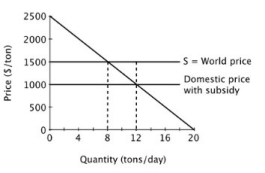 If the government provides a subsidy of $500 per ton, then consumer surplus will be ________ per day.
If the government provides a subsidy of $500 per ton, then consumer surplus will be ________ per day.
A) $1,000
B) $4,000
C) $8,000
D) $9,000
Correct Answer

verified
Correct Answer
verified
Multiple Choice
The figure below depicts the short-run market equilibrium in a perfectly competitive market and the cost curves for a representative firm in that market. Assume that all firms in this market have identical cost curves. 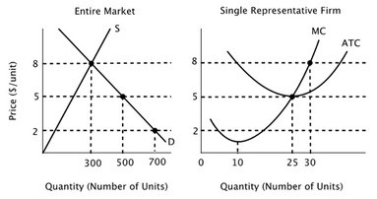 The long-run market equilibrium quantity in this industry is:
The long-run market equilibrium quantity in this industry is:
A) 300.
B) 500.
C) 700.
D) more than 700.
Correct Answer

verified
Correct Answer
verified
Multiple Choice
Assume that all firms in this industry have identical cost curves, and that the market is perfectly competitive. 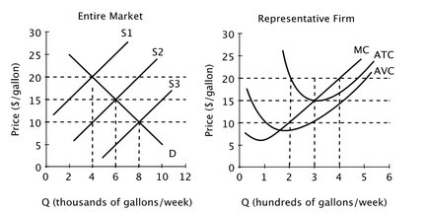 If the market supply curve is given by S3, then what will happen to the market supply curve in the long run?
If the market supply curve is given by S3, then what will happen to the market supply curve in the long run?
A) It will stay at S3, but the quantity supplied will increase.
B) It will shift to S2.
C) It will shift to S1.
D) It will stay at S3, but the quantity supplied will decrease.
Correct Answer

verified
Correct Answer
verified
Multiple Choice
Suppose a small island nation imports sugar for its population at the world price of $1,500 per ton. The domestic market for sugar is shown below. 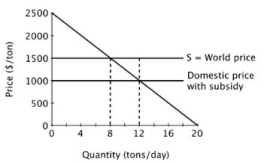 With no subsidy, what is consumer surplus?
With no subsidy, what is consumer surplus?
A) $1,000 per day
B) $4,000 per day
C) $8,000 per day
D) $9,000 per day
Correct Answer

verified
Correct Answer
verified
Multiple Choice
In perfectly competitive markets, an implication of entry and exit in response to economic profit and loss is that:
A) firms must earn positive economic profit in the long run.
B) firms will produce the quantity that minimizes average variable costs in the short run.
C) firms will produce the quantity that minimizes average total costs in the long run.
D) market demand is completely elastic.
Correct Answer

verified
Correct Answer
verified
Multiple Choice
In an industry with free entry and exit, positive economic profit:
A) indicates a market failure.
B) can never occur.
C) cannot be sustained indefinitely.
D) can be sustained indefinitely.
Correct Answer

verified
Correct Answer
verified
Multiple Choice
If all firms in a perfectly competitive industry are earning a normal profit, then:
A) new firms will enter the industry.
B) existing firms will exit the industry.
C) there is no incentive for firms to enter or exit the industry.
D) the market supply curve will shift to the left.
Correct Answer

verified
Correct Answer
verified
Multiple Choice
An example of an implicit cost is:
A) interest paid on a bank loan used to purchases equipment.
B) wages paid to a family member who works at the firm.
C) the value of a spare bedroom turned into a home office.
D) operating costs of a company-owned car.
Correct Answer

verified
Correct Answer
verified
Showing 121 - 140 of 159
Related Exams